RELG 402 - World's Living Religions
Early Chinese History
In the earliest stages of religion in China, before Confucianism and Taoism developed, there was an awareness of the spirit world, and the concept of a "High God", Shang Di.
During this period various "culture heroes" made innovations which are still commemorated in folk religion. Some of these heroes are revered as divine beings in Chinese folk religion.
Fu Xi (ca. 2652 BC), the Ox-tamer, is credited with domesticating animals and with inventing nets for catching animals and fish, and also inventing marriage and thus instituting the family. He is also credited with inventing divination and the eight trigrams.
Shen Nong (ca. 2737 BC), the Divine Farmer, is credited with inventing the hoe and the plough, and with teaching the art of agriculture to the people.
 Huang Di (ca. 2697 BC), the Yellow Emperor, invented warfare, and drove the "barbarians" out of what became the homeland of the Chinese Empire. His wife is credited with inventing silk culture.
Huang Di (ca. 2697 BC), the Yellow Emperor, invented warfare, and drove the "barbarians" out of what became the homeland of the Chinese Empire. His wife is credited with inventing silk culture.
The next period of the history of China is referred to as the Age of the Sage Kings, or the Age of the Five Emperors - a legendary golden age of wise rulers and good government. It appears also to have been a time of inter-tribal warfare between some of the tribes which eventually merged to become the Chinese people.
King Yao (ca. 2357 BC) decided that none of his own sons was worthy of becoming king, so searched for the most virtuous man in the kingdom to succeed him. His concept of virtue was filial piety, and he found Shun, who continued to honor and serve his father and step-brother without complaint, although they tried several times to kill him.
King Shun (ca. 2255 BC) also did not hand the kingdom on to one of his sons, but chose Yu, who had worked to protect the people from the devastating floods which occurred in China.
King Yu the Great (ca. 2705) founded the Xia dynasty, which was in power during the period 2205-1766 BC. He worked tirelessly to protect the people from the periodic flooding of the Yellow River. He built sluices and dams across the river, and canals to carry the flood-waters away, and made the land habitable, then he divided the land into provinces to facilitate government. It is said that he worked until his fingers had no nails, his internal organs failed, and his legs became so weak that he could hardly walk. He is revered as an example of a hero who dedicated his life to caring for his people.
King Yu broke the tradition of choosing the most worthy man to succeed him, and appointed his own son as the next ruler, thereby introducing the system of rule by one family and founding the Xia dynasty. The last ruler of the Xia dynasty was corrupt, and was overthrown by Tang, first ruler of the Shang dynasty.
The Xia dynasty (ca. 2205-1766 BC) was followed by the Shang dynasty (1766-1050 BC). During this period Chinese religion was characterized by worship of Shang Di (the Lord most High) and by divination and ancestor worship.
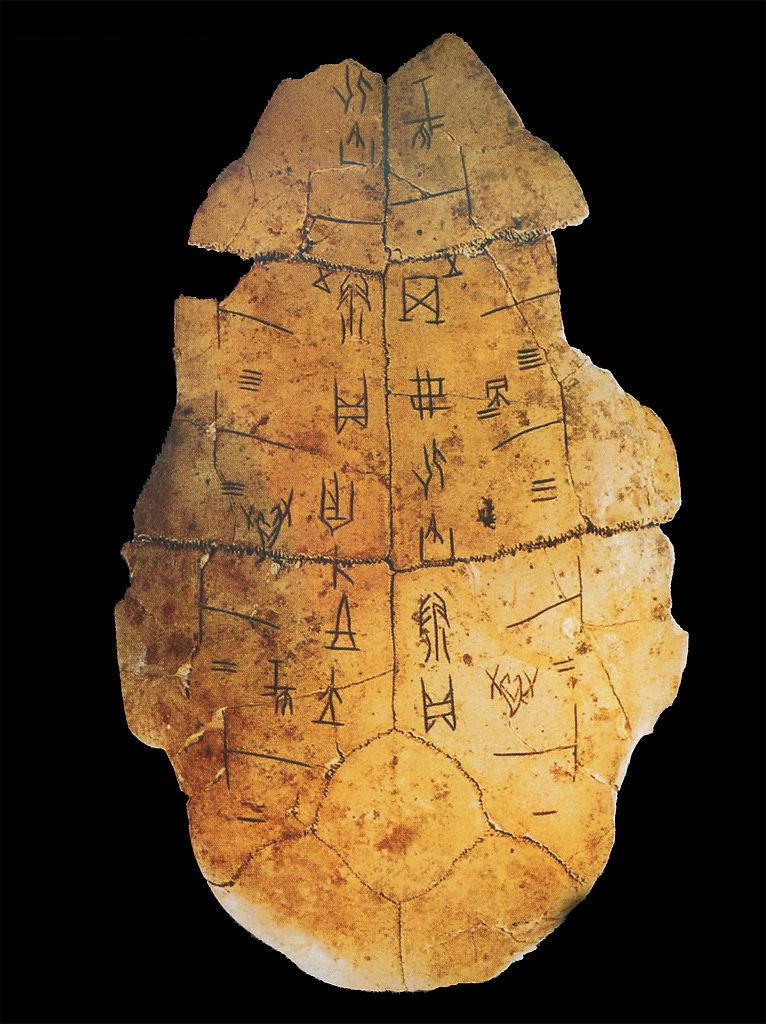
 Divination was often performed by the use of "oracle bones" - typically the scapula of an ox or a sheep, or the shell of a turtle. A question and its answer(s) were inscribed on the bone, and a heated rod was pressed into the bone. The resulting pattern of cracks would be interpreted by a diviner. It was believed that the ancestors or some other spirits had responded with the correct answer.
Divination was often performed by the use of "oracle bones" - typically the scapula of an ox or a sheep, or the shell of a turtle. A question and its answer(s) were inscribed on the bone, and a heated rod was pressed into the bone. The resulting pattern of cracks would be interpreted by a diviner. It was believed that the ancestors or some other spirits had responded with the correct answer.
The script used on the oracle bones is the earliest known form of Chinese writing,
Archaeological evidence suggests that animal and human sacrifice were practiced during the Shang period. Also, in order to provide the dead ruler with comforts in the after-life, hundreds of horses and people, probably slaves, would be buried alive with the royal corpse.
The Shang rulers asserted their supremacy by taking on the role of high priests, and by leading the religious ceremonies and divination procedures. Sacrifices were made not only to Shang Di, but also to various natural powers such as the sun, and to the ancestors of the rulers.
During the Zhou dynasty (1050-256 BC) Shang Di, the High God, was regarded as so distant that he had little care for humanity and its affairs, and the concept of "Heaven", Tian, developed. Tian presided over the spirits of the dead, and gave a mandate to the Emperors (the Mandate from Heaven).
The concept of the Mandate from Heaven, and the ruler being the "Son of Heaven" was introduced by the rulers of the Zhou dynasty to validate their deposing the Shang dynasty - they claimed that the last Shang rulers had been so bad that Heaven had decreed their downfall.
If an Emperor was pleasing to Tian, things would go well with the land. If the Emperor was unworthy the Mandate would be withdrawn and there would be famine, floods, other natural disasters, and rebellion. If this happened the Emperor could be deposed and a more worthy ruler appointed.
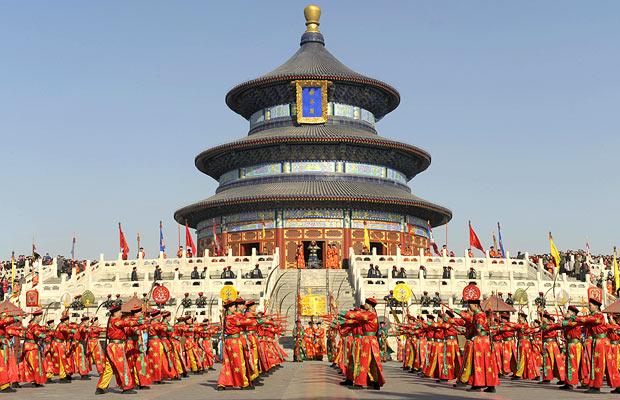 It was the Emperor's duty to perform the annual sacrifices in the Temple of Heaven in the capital city (now called Beijing). This was so sacred a place that common people were not allowed there, and were not even allowed to watch the Emperor's procession to the Temple to perform the sacrifices. At the winter solstice he sacrificed a red bullock, and offered jade, silk, wine and incense to Tian. This was supposed to guarantee the orderly behavior of nature through the year, and a bountiful harvest. During this period the Emperor became regarded as the "Son of Heaven" - a title which was used by the Emperors of China until the last Emperor was deposed by the Chinese Communists in the early 20th century.
It was the Emperor's duty to perform the annual sacrifices in the Temple of Heaven in the capital city (now called Beijing). This was so sacred a place that common people were not allowed there, and were not even allowed to watch the Emperor's procession to the Temple to perform the sacrifices. At the winter solstice he sacrificed a red bullock, and offered jade, silk, wine and incense to Tian. This was supposed to guarantee the orderly behavior of nature through the year, and a bountiful harvest. During this period the Emperor became regarded as the "Son of Heaven" - a title which was used by the Emperors of China until the last Emperor was deposed by the Chinese Communists in the early 20th century.
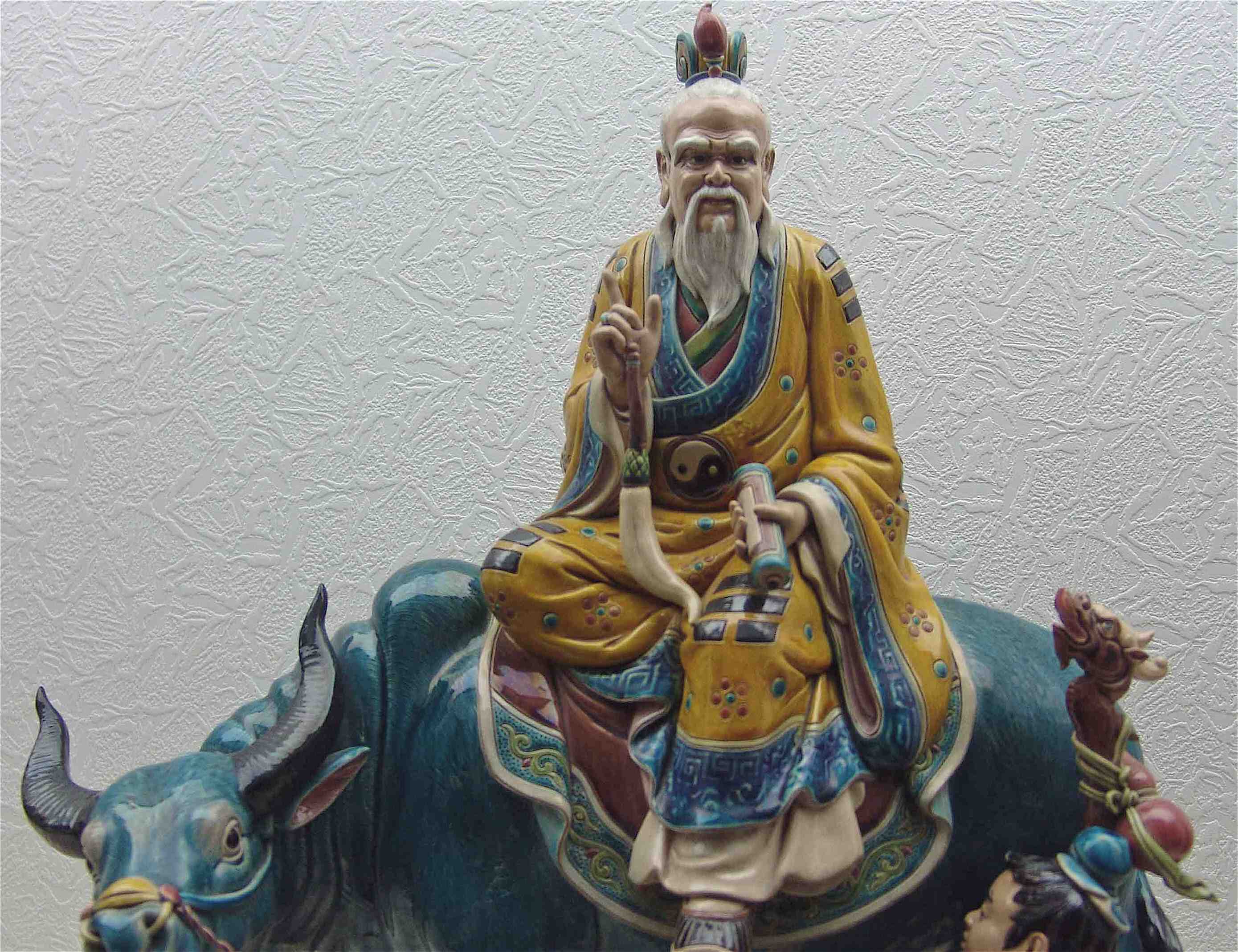 |
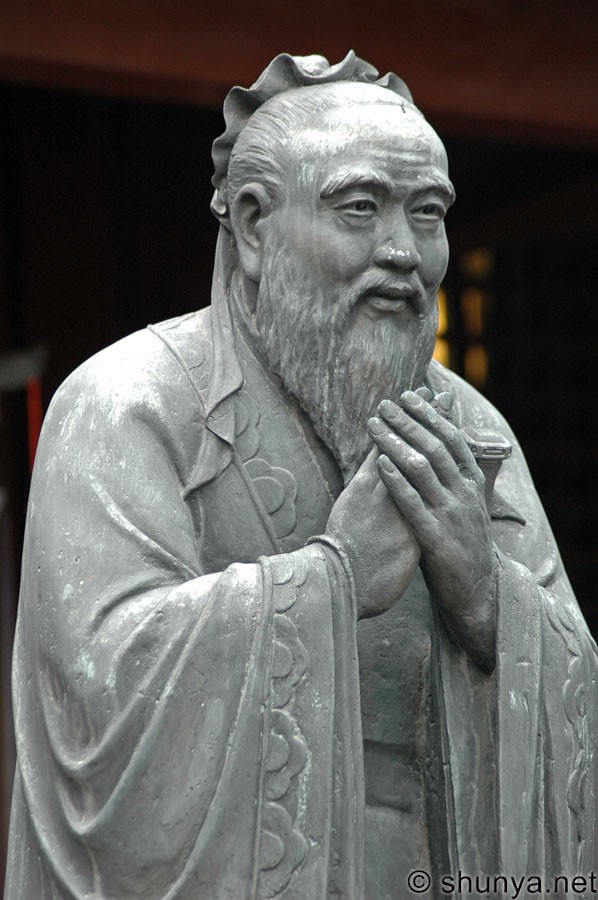 |
 |
| Laozi | Confucius | Mencius |
During the Zhou period there was a flowering of philosophy - the "Hundred Schools of Thought". Laozi (ca. 604 BC), Confucius (551-479 BC), and Mencius (371-289 BC) were part of this development. The concepts of qi and of Yin-Yang came into prominence, and the Six Classics of Confucianism were written.
The Qin dynasty (221-207 BC) succeeded the weakened Zhou dynasty, when Qin Shihuang proclaimed himself the First Emperor (rather than King) of a greatly enlarged territory. During this period the Great Wall of China was built, the writing system was standardized, and the bureaucracy was strengthened.
However, in order to suppress independent thought, the First Emperor initiated the persecution known as the "burning of books and burying of scholars" (213 BC).
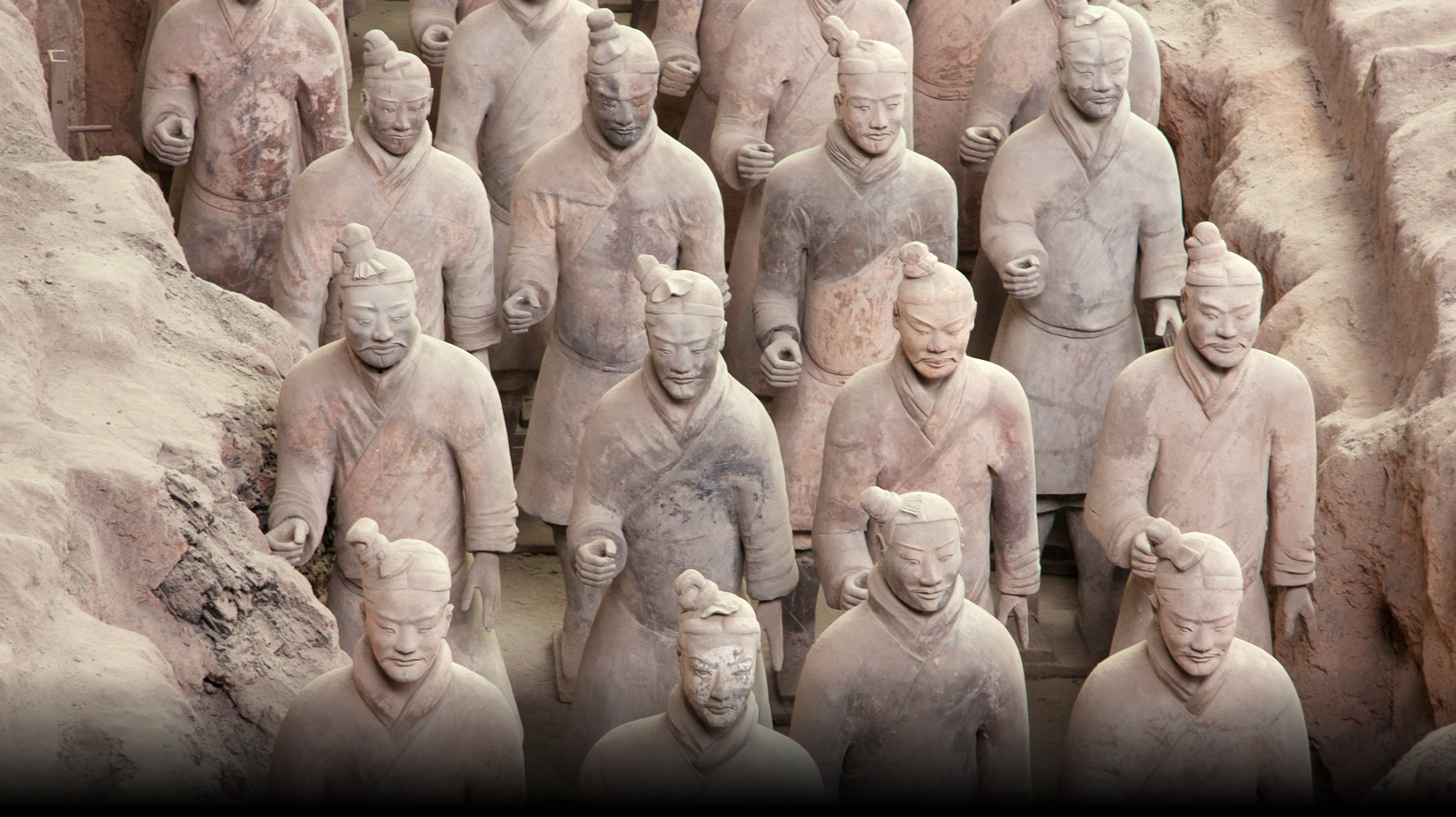 On the death of the First Emperor huge armies of terracotta soldiers, servants, and horses were buried around his tomb. These were discovered in 1974 and have become world-famous. The burial chamber of the Emperor has not yet been discovered, Whether or not some of his concubines and other servants were buried alive is a matter for debate.
On the death of the First Emperor huge armies of terracotta soldiers, servants, and horses were buried around his tomb. These were discovered in 1974 and have become world-famous. The burial chamber of the Emperor has not yet been discovered, Whether or not some of his concubines and other servants were buried alive is a matter for debate.
After the death of the First Emperor in 210 BC there was warfare between competing groups for control of a boy emperor, leading to rebellion and the seizure of power by a soldier who became the first Han Emperor.
The Han dynasty (206 BC - 9 AD, and 25-220 AD) succeeded the Qin dynasty when Liu Bang (who became Emperor Gaozu) defeated his rivals and seized power over the Chinese states. The Han dynasty was characterized by internal strife and rebellion, with power wielded by palace eunuchs and Empresses. The Emperor Wu made Confucianism the state religion and abolished all academic positions which were not in accord with Confucianism, but it was during the Han dynasty that Buddhism entered China.
The emperor acted as the highest priest in the land, and made sacrifices to Heaven, to the main deities, and to the spirits of mountains and rivers. The doctrines of Yin-Yang and the Five Phases were also popular.
It was believed that if the emperor did not behave according to proper ritual, he could disrupt the fine balance of cosmological cycles he would lose the Mandate of Heaven and cause calamities such as earthquakes, floods, droughts, epidemics, and swarms of locusts
Buddhism was first mentioned in 65 AD, and Buddhist texts were translated into Chinese during the second century AD.
Groups of Daoists began to form religious movements by about 200 AD.
However, families throughout Han China still made ritual sacrifices of animals and food to deities, spirits, and ancestors at temples and shrines. They believed that a person had a two-part soul : the spirit-soul (hun) which journeyed to the afterlife paradise of the immortals (Tian), and the body-soul (po) which remained in the grave on earth.
The Silk Road - the trade route between China and the West - was developed during the Han dynasty.
Copyright © 1999 Shirley J. Rollinson, all Rights Reserved